Mobile recruiting is the process of reaching out to job seekers and taking them through the application process via their mobile devices. It seems simple, but to do this well takes more than just a mobile-friendly website. The best mobile recruiting functions fully utilize mobile technology, enabling a smooth process and quick and easy communication for job seekers and your hiring team.
HR software like ZipRecruiter can make mobile recruiting easy. ZipRecruiter allows you to manage your job ads and track applicants right from your mobile device.
Mobile Recruitment Strategies
Finding employees using mobile recruitment requires many of the same job advertising skills as any other recruiting style. Start with a clear job ad with strong keywords that will help interested people find it in a search. Ensure your “About” page and social media feeds showcase your company in its best light. Also, especially on mobile, take out any unneeded steps that lengthen the application process or otherwise make applying difficult.
Consider these specific strategies to make your mobile hiring experience its best:
Recruiting Pages
Mobile-friendly career websites are crucial for effective mobile recruiting. This goes beyond just aesthetics. These ensure easy access to job listings, company information, and applications, while providing a smooth and enjoyable user experience.
Having a recruiting page on your website also impacts your organization’s reputation and competitiveness in the job market. A well-designed, mobile-responsive site conveys professionalism and a commitment to staying current with technology trends, which can make your company more appealing to tech-savvy candidates. On top of that, search engines prioritize mobile-friendly websites in their rankings, which can improve your site’s visibility in search results, driving more organic traffic.
Want more tips and strategies for finding employees that are a good fit for your business? Read our guide on How to Find Employees You’ll Love.
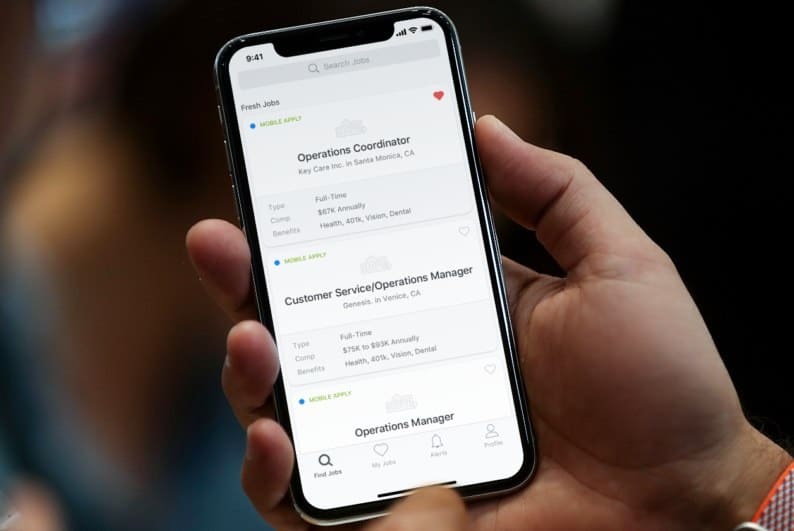
ZipRecruiter puts mobile recruiting at your fingertips. (Source: ZipRecruiter)
Geo-targeted Ads
Geo-targeted job ads are a type of online advertising that allows employers to target potential employees in a specific geographic area. This can be done through online job boards, social media, and other online platforms.
Geo-targeting can benefit both employers and employees—it allows employers to reach a larger pool of potential employees, and employees can search for jobs in their specific geographic area.
Optimized Applications
Most people use their mobile devices to access applications. While many applications are designed to be used on mobile devices, some are not. For the best experience possible when using an application on a mobile device, optimizing it for that platform is important.
Mobile optimization goes beyond making sure your recruiting tool is good for mobile. You should also:
- Optimize your keywords
- Keep job descriptions simple and direct
- Allow buttons rather than typing where possible
- Avoid making applicants move from webpage to webpage to get things done
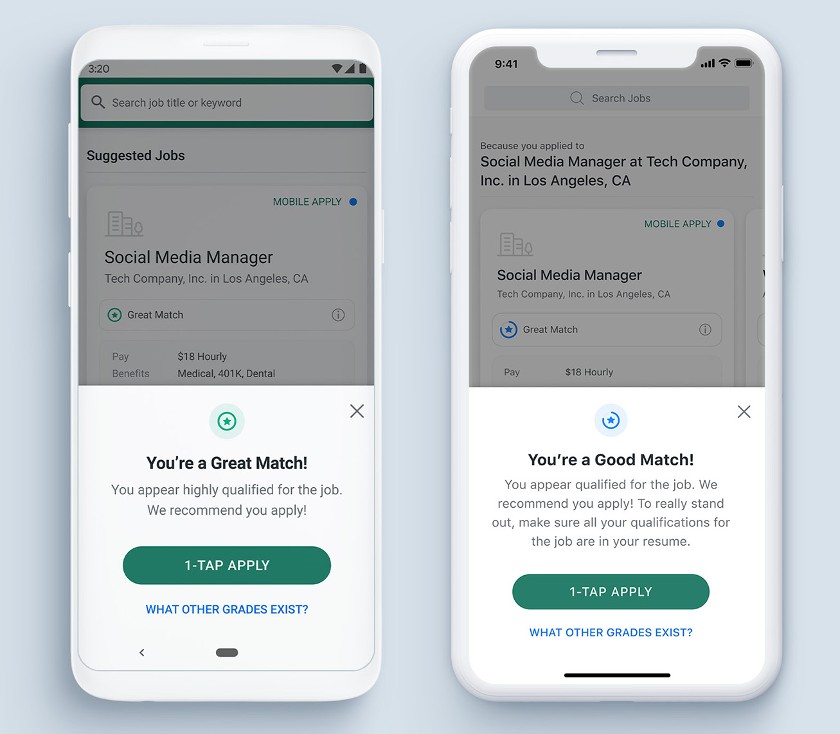
ZipRecruiter will match your optimized applications to job seekers that may be a fit for your open positions.
Additionally, mobile devices differ from desktop or laptop computers in that the screen size is typically smaller, and they usually have different input methods (people use their fingers versus a mouse or trackpad). Designers must consider how users will interact with the surface, how much space is available, and how users will input information into the application.
In addition to optimizing the job application for mobile, keep the information to the essentials. It’s been shown that 60% of applicants will give up on an application that is too long or complex—whether a traditional application or on a mobile device.
Looking for a recruiting app to help you with your talent acquisition? Check out the best recruiting apps for small businesses.
Mobile Communication Options
Since the majority of Americans own a smartphone, it’s important for businesses to communicate with job seekers in a mobile-friendly way. This ensures that job seekers can easily find and apply for jobs on the go and reach you via text, email, or phone call, in case of questions.
Sometimes, applicants want to know more before going through the application process. Those using mobile especially expect a way to reach out and communicate before going through the application process. This can also be an advantage to you, as you may be able to screen some candidates before putting them in the application chain.
You should also consider communicating with job seekers via text message. Text messages have a high open rate, and people are more likely to read a text message than an email, so you’re more likely to reach potential candidates if you send them a text message. Just be sure to keep your messages clear and concise.
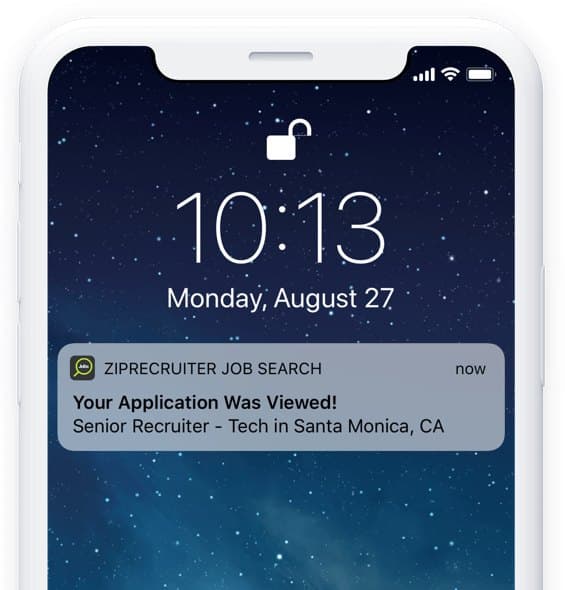
Set up notifications in ZipRecruiter
According to Emissary and Aptitude Research, 40% of companies increased their use of texting in recruitment in 2022. Texts generally get immediate attention, whereas emails can be lost or ignored—and even if someone has email on their phone, it’s still a process to get to, whereas texts are one tap away.
Social Media Recruitment
According to the Harris Poll, more and more employers are utilizing social media profiles (most specifically LinkedIn profiles) during their hiring process rather than resumes. It makes mobile recruiting much easier for both the applicant and the recruiter/employer. For employers, they can readily access the information they need on the applicant’s online profile with just a click.
On the other hand, smart job seekers will make sure they have a strong profile, so consider letting them apply via LinkedIn rather than filling out a complex application online. You can also host live events via Facebook Live, WhatsApp, and others.
According to CareerArc, 86% of job seekers search for jobs through social media. Make sure your social media pages are up-to-date and reflect your company culture and your product.
QR Codes
QR codes are popular for payment processing and item information, but they can also be used for hiring. Having a kiosk or even a sign at the counter with a QR code that leads to your application site can increase applicants, making it a great tool for restaurants and retail. Further, this makes you more accessible to people who already love what you do and are familiar with your business.
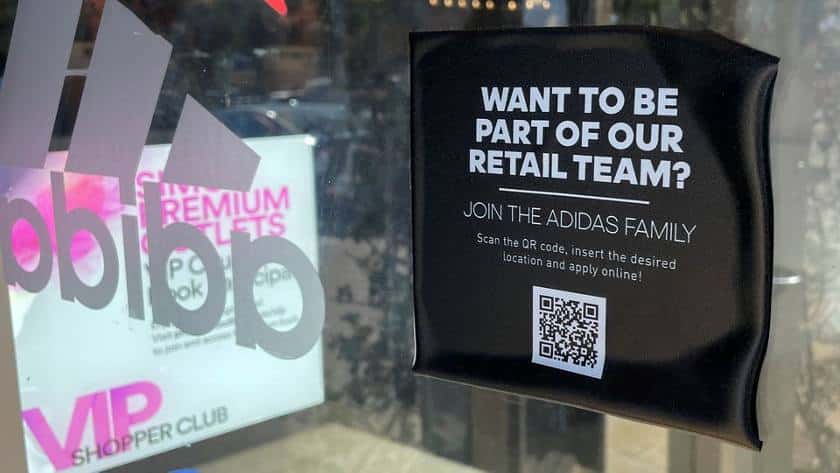
QR codes make applying through a mobile device quick and easy. (Source: Reuters)
Mobile Recruiting Tips
To make your recruiting process mobile-friendly, you need to consider the entire process from start to finish. This means making sure your job postings are easily viewable and accessible on mobile and that the application and interview process can also be completed on a mobile device. It can be annoying to an applicant to start on mobile, only to have to move to a desktop for communication, applications, or other parts of the process.
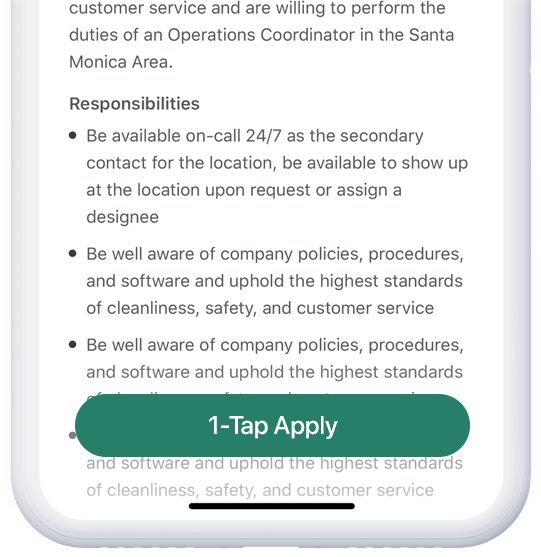
ZipRecruiter offers 1-Tap Apply for all job ads.
Additionally, you should consider making your offer letters and other communications mobile-friendly so they can be easily viewed and accessed by candidates. These steps will help make your recruiting process mobile-friendly and more accessible to all candidates.
Here are a few more tips to make your mobile recruiting more effective:
- Use a responsive design: If you have a recruitment page, it should automatically adjust its layout to fit the screen size of the device it is being viewed on. This ensures that your content looks good when viewed on desktop and mobile devices.
- Use larger fonts and clear images: Mobile devices often have smaller screens. Using large fonts and clear images ensures that candidates read and understand the information.
- Keep your content concise: People who use their mobile devices are often on the go, so they don’t have the time to read long blocks of text. Thus, it makes sense to keep your content concise and to the point.
- Make it easy to apply for a job: Use short forms and clear instructions to make the application process easier.
- Give candidates options on how to apply: Mobile applications should not just be easy but convenient and fast for applicants. Give them options to apply either via email or text message.
- Use a call to action: Tell applicants what you want them to do next, such as apply for a job or learn more about your company.
Mobile Recruiting Benefits
More than 60% of candidates applying for jobs use their mobile devices, according to Appcast’s 2022 Recruitment Marketing Benchmark Report. However, mobile recruiting is not only important for reaching candidates—it also improves your employer brand by showing that your company is forward-thinking and technology-minded.
Some other benefits of mobile recruiting include:
- Reach younger candidates: Even before COVID struck, many people were already using their mobile devices to search for jobs. For Gen Z, the expectation for mobile is even higher. According to a 2021 Pew Research, most Gen Zs use Instagram, Snapchat, and TikTok. In response, these social media platforms, like TikTok, teamed up with global brands to use their platforms as a recruitment tool.
- Quicker communication: Gen Z also expects text communication. Two-thirds say that texting shows a company is tech-savvy, a quality they expect. Regardless of generation, however, applicants are expecting faster replies. Texting makes it easy—plus, you’re more likely to be heard as most studies and surveys indicate an open rate for text messages of nearly 100%.
- Recruiters can work anywhere: Mobile recruiting isn’t just about convenience for the candidates. It allows managers and hiring authorities to work via mobile as well, so they can work even when not near the computer. For example, a restaurant manager who was too busy during open hours to get to the computer can quickly review candidates and send texts over the phone from home. It also makes it easier to quickly react to a new applicant no matter when they submit.
Learn the basics! Read our article on how to hire employees. You can also get some recruiting insights from these hiring statistics.
Mobile Recruiting Limitations
While employers/recruiters can utilize mobile recruiting to attract top talent, it also has some limitations. Here are some situations where mobile recruiting might not be a good fit:
- Highly Technical Jobs: If the job requires a lot of technical skills, such as software development or engineering, it may be better to use traditional methods of recruiting, such as online job boards or career fairs. This is because mobile devices may not be able to display all the information about the job or the company, and it may be difficult for candidates to apply for the job on a mobile device.
- Elaborate Application Processes: If the application process for a particular job involves uploading multiple documents, filling out extensive forms, or completing complex assessments, it might be cumbersome for candidates to navigate on mobile devices. This could potentially lead to a suboptimal candidate experience.
- Regulated or Highly Confidential Roles: If the job requires a lot of confidentiality, such as working with sensitive data, it may be better to use traditional methods of recruiting, such as face-to-face interviews. This is because it can be difficult to ensure confidentiality when communicating with candidates on a mobile device.
- Roles with Complex Assessments: If the job posting involves complex assessments, tests, or coding challenges that require precision, candidates might prefer the accuracy and ease of using a keyboard and larger screen.
- Creative Roles with Portfolios: Jobs that require candidates to showcase portfolios of creative work, such as designers, artists, or architects, might face limitations in terms of presenting their work effectively on small mobile screens.
Mobile Recruiting Apps
Many of the best recruiting software handle mobile recruiting as well as website job postings. Look for those that optimize for mobile, allow text messaging within their system, and have tools that utilize social media. The following recruiting tools have mobile app versions:
- ZipRecruiter: ZipRecruiter has 25 million active users per month; 70% of them search on mobile.
- ZohoRecruit: Zoho Recruit has a mobile app that lets your team members handle the hiring process from their phone, including calling or texting candidates with a tap.
- Indeed: Indeed says 75% of its 250 million unique visitors each month use mobile for job hunting.
- Workable: Workable is a recruiting platform that streamlines the hiring process with automation, self-scheduling, e-signatures, and other features. It also offers a wide range of templates, background checks, and in-app collaboration tools.
Find out more about these in our guide to the best recruitment software.
Bottom Line
A few years ago, mobile applications surpassed desktop applications for the first time. Your business cannot ignore mobile recruiting, especially if you are looking for the next generation of employees (54% of Gen Z candidates will pass by a business if they think you have outdated recruiting methods). Consider the tips we discussed above—including simplifying the application process, allowing documents to be sent via mobile, and communicating through text—to get the most out of your mobile recruitment strategy.